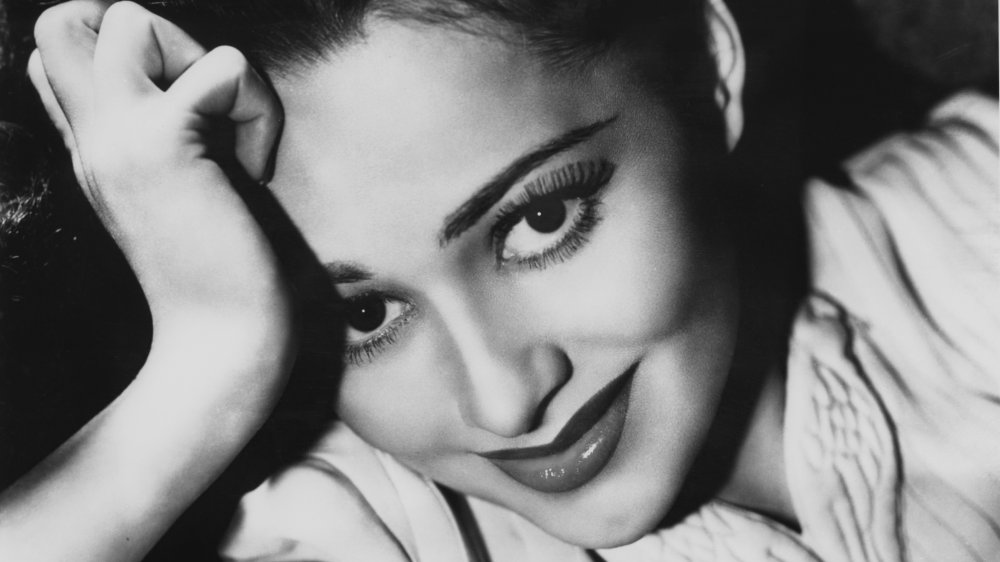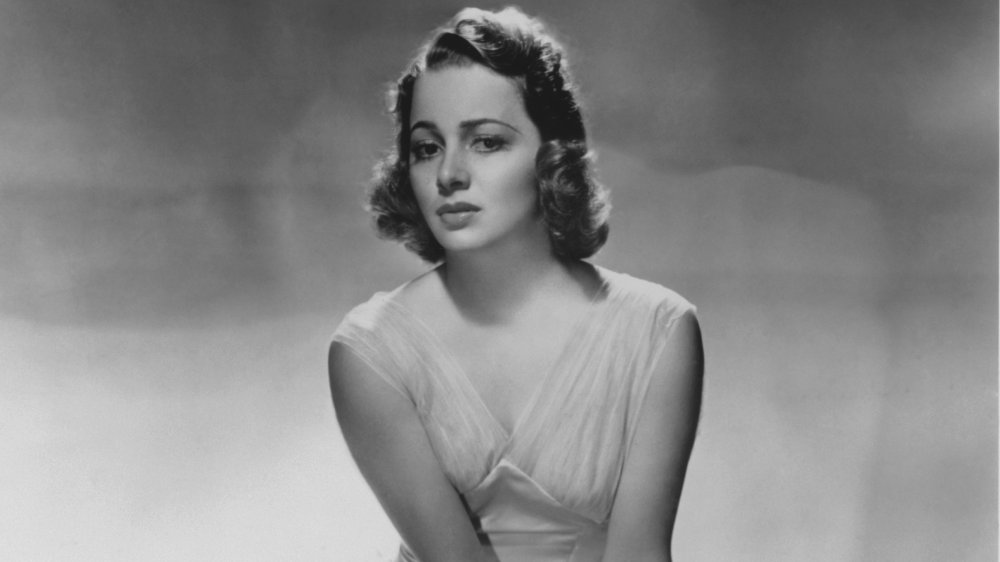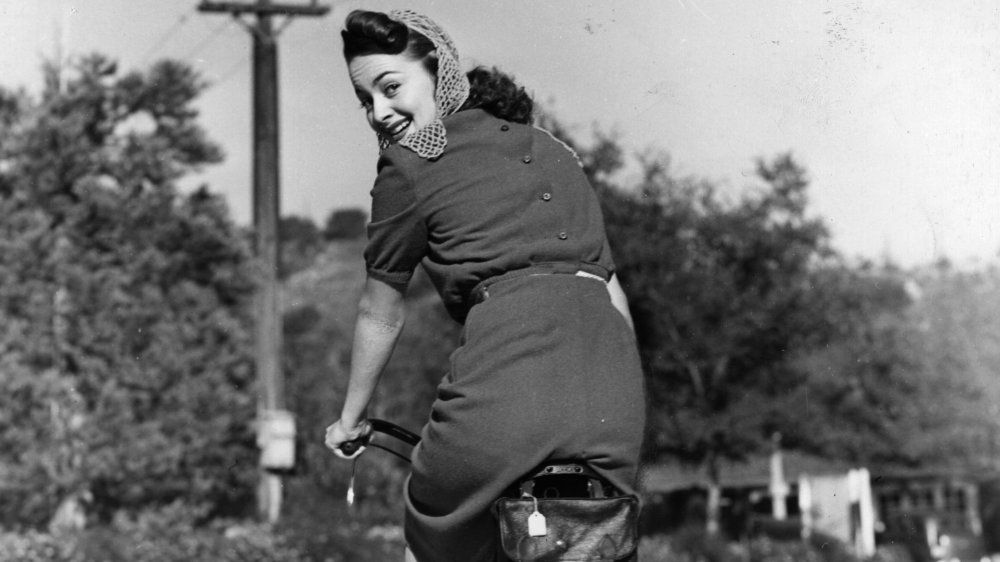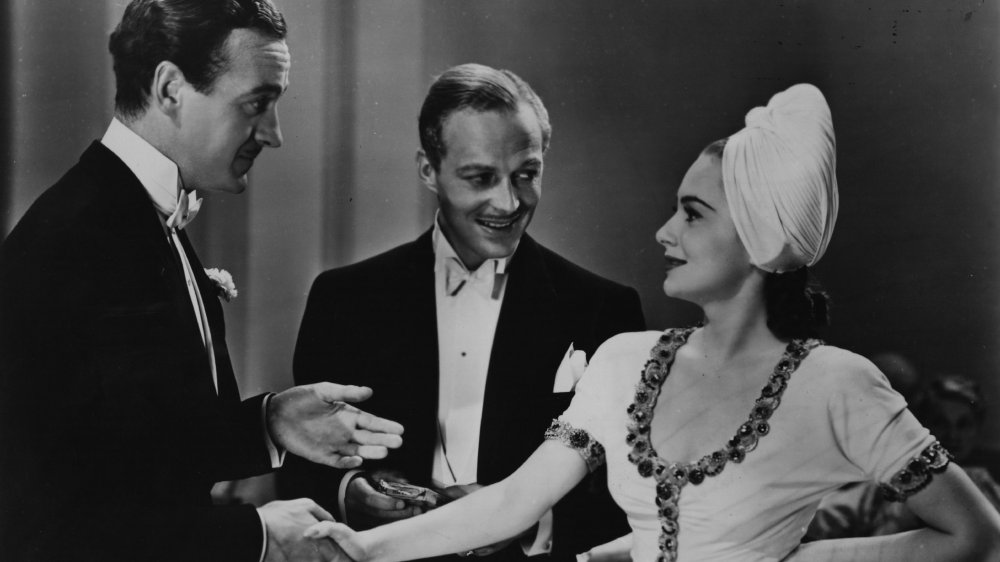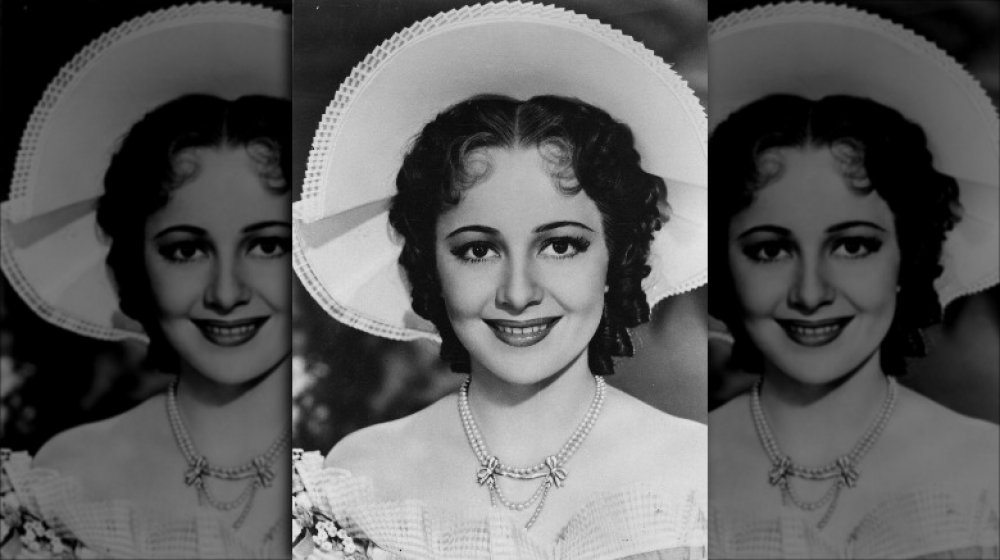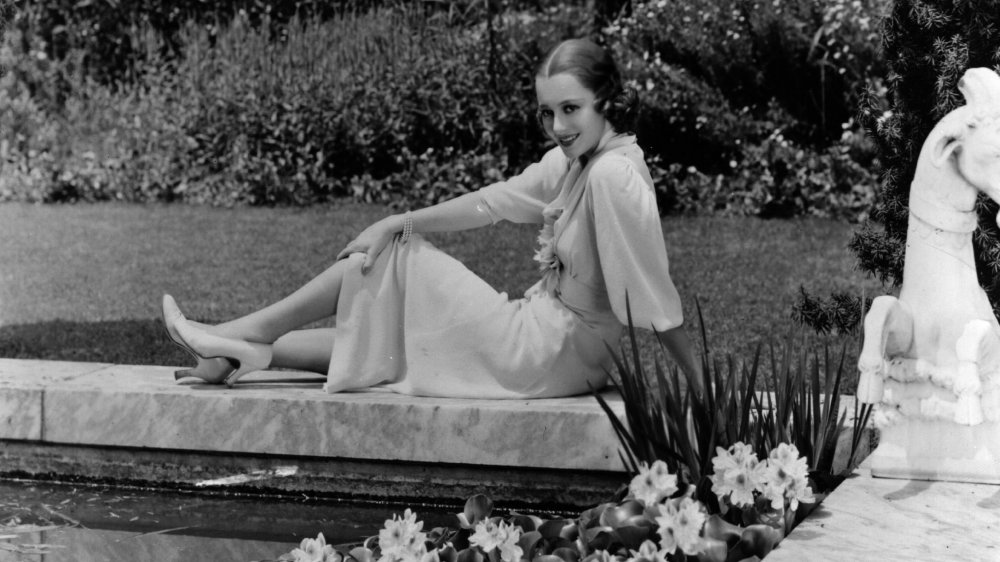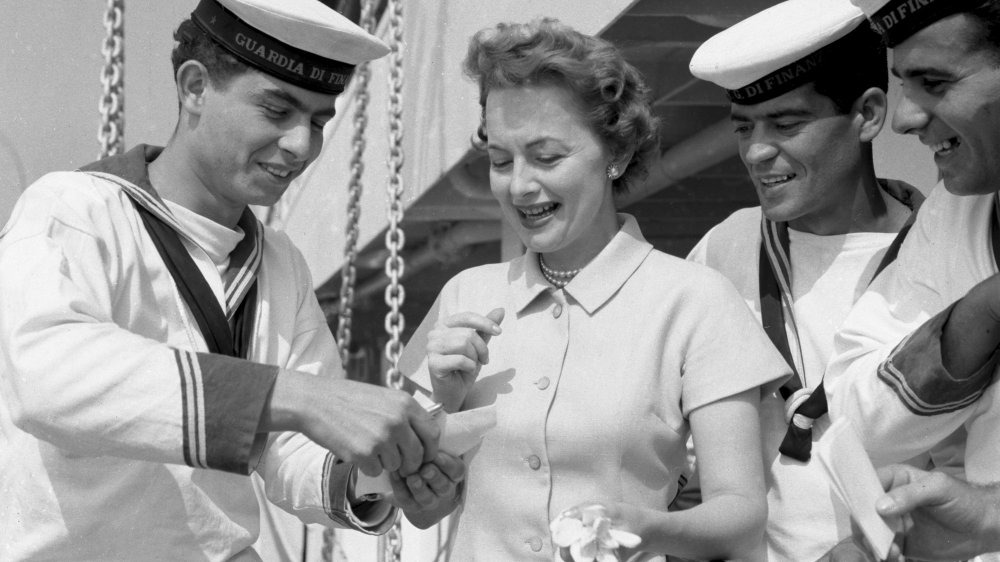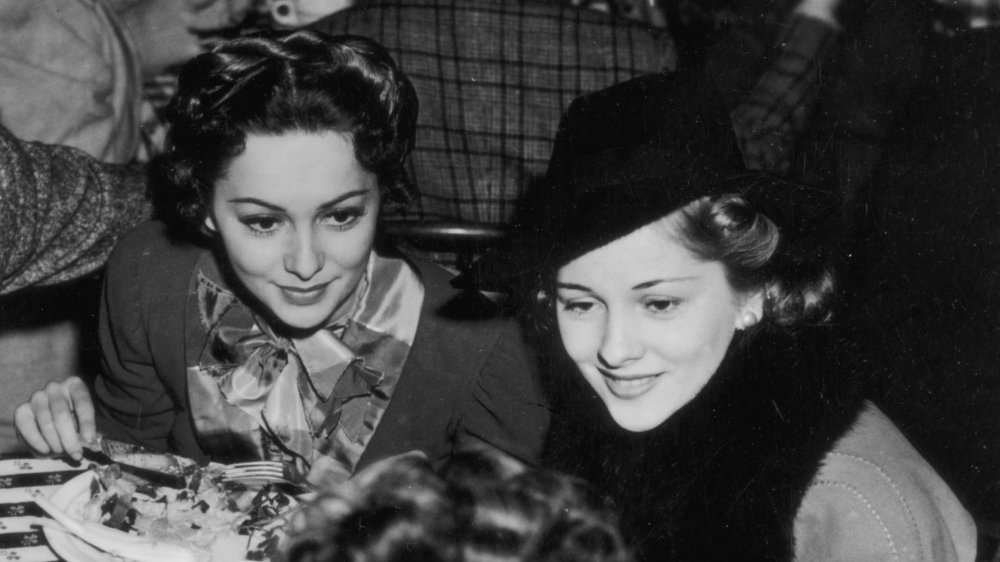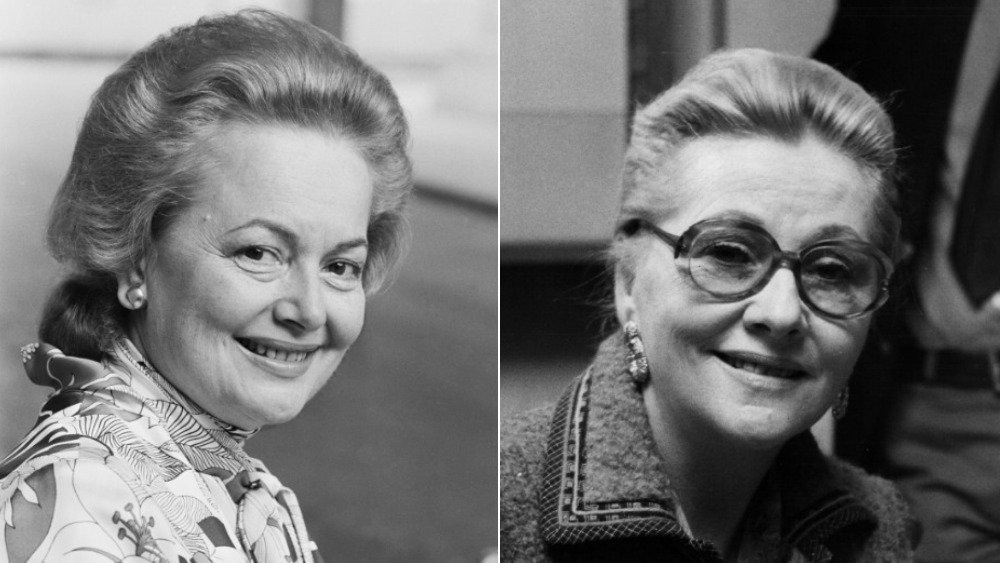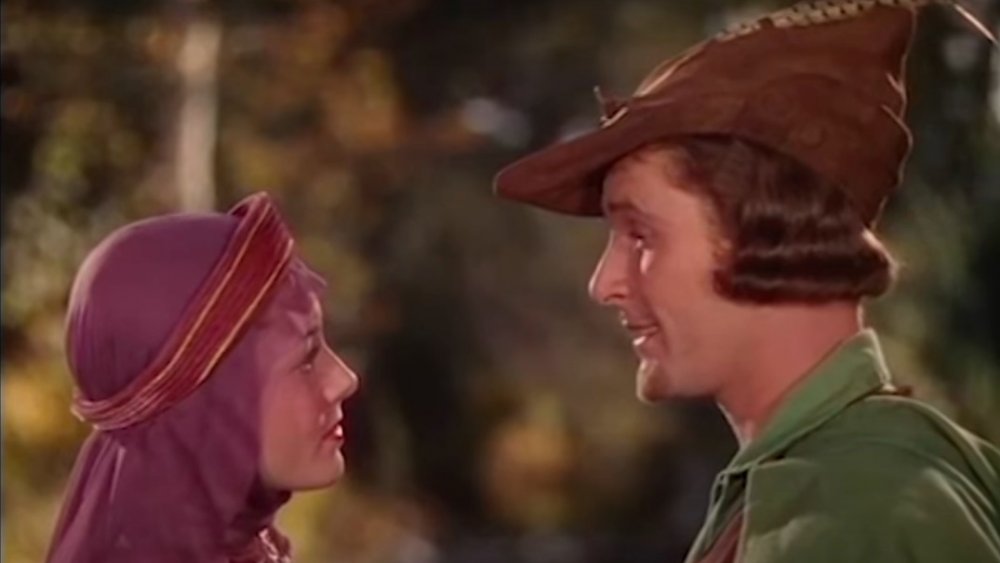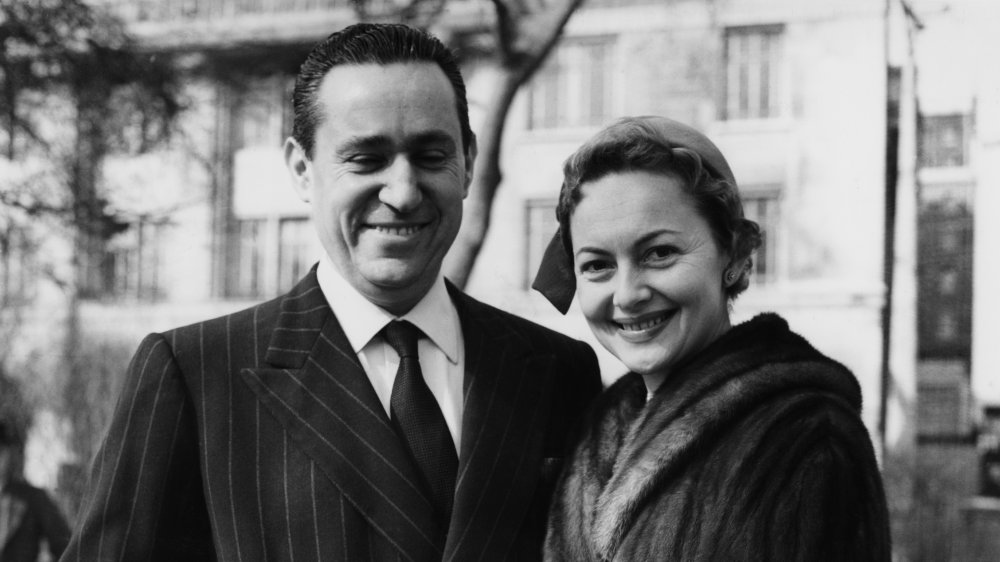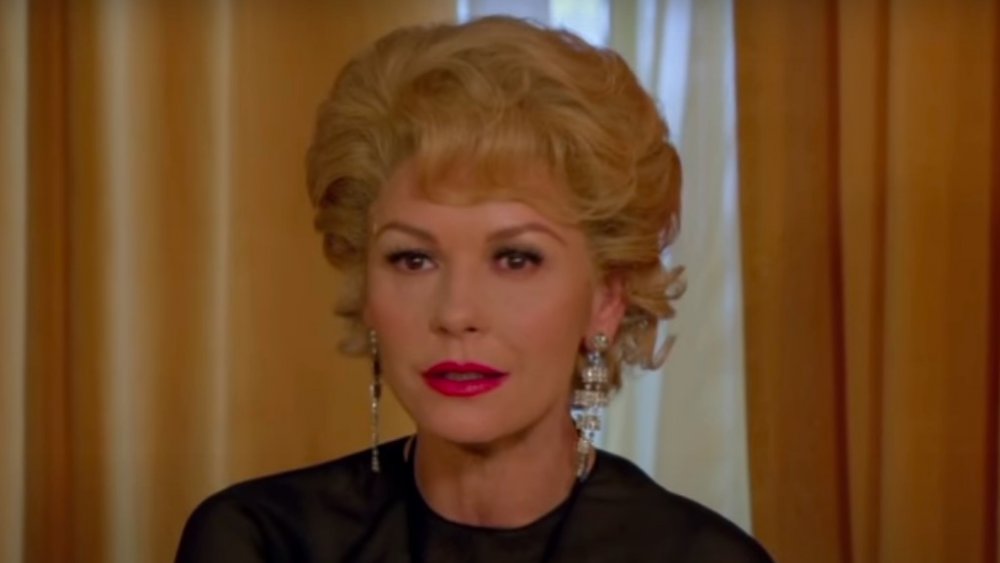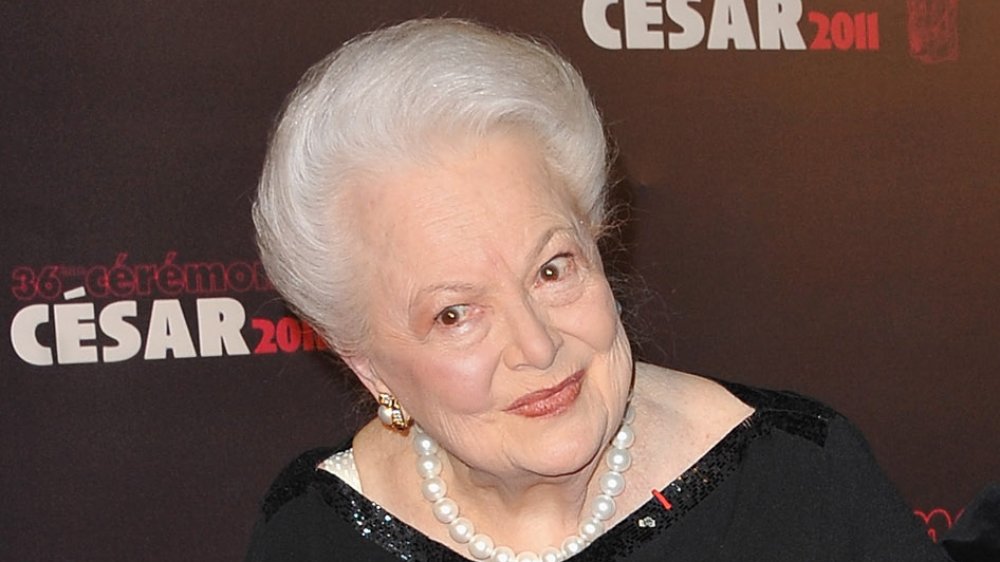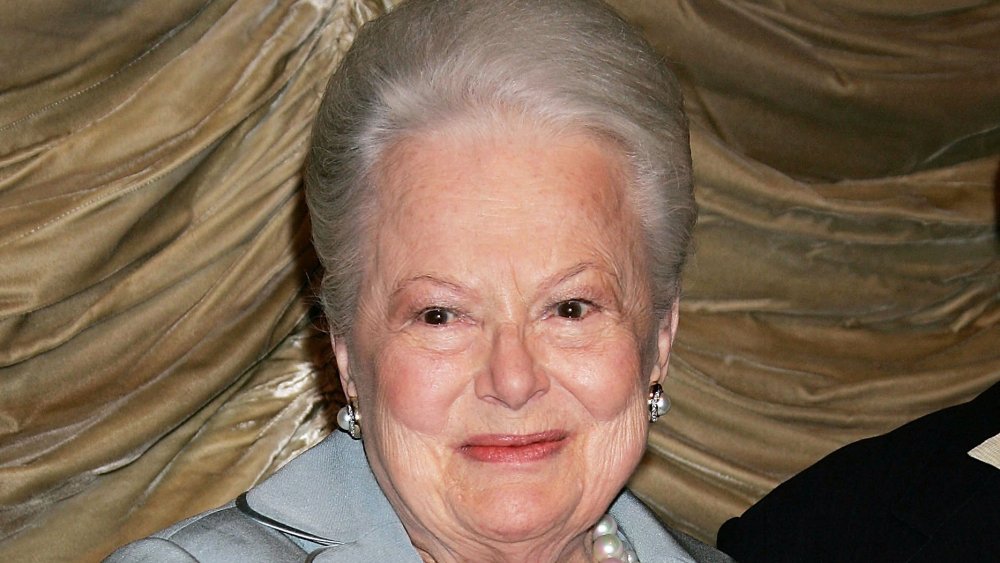Tragic Details About Olivia De Havilland
The word "icon" tends to get thrown around a lot in Tinseltown, but it's an apt term to describe Olivia de Havilland. The actress, who passed away in her sleep on July 25, 2020, at the ripe old age of 104, enjoyed a successful showbiz career that spanned nearly six decades, including an Oscar-nominated role in Gone with the Wind. As the last surviving star of this 1939 classic, de Havilland would be nominated for four more Oscars, ultimately winning her first Academy Award in 1947 for her performance in To Each His Own, and her second best actress Oscar for The Heiress three years later.
When her career was at its peak in the '50s, de Havilland left Hollywood, moving to Paris with her French husband. The marriage ended two decades later, and de Havilland would continue to act until the late '80s — but she stayed in Paris, living out her remaining decades in good health. "Life is too full of events of great importance. That is more absorbing and enriching than a fantasy life," she once said of retiring (via Today). "I don't need a fantasy life as once I did. That is the life of the imagination and I had a great need for it. Films were the perfect means of satisfying that need."
While the Old Hollywood legend's life was largely characterized by success and contentment, her journey was not without difficulties. These are some of the more tragic details of Olivia de Havilland's life.
Olivia de Havilland's distant relationship with her absent father
Olivia de Havilland was born in Tokyo in 1916 to British parents. Her father, Walter, noted Victoria Amador's biography Olivia de Havilland: Lady Triumphant, was a lawyer, while her mother, Lillian, was an actress and voice teacher. While Lillian's acting career never lived up to her lofty aspirations, she passed her theatrical ambitions on to her two children, Olivia and younger sister Joan.
In 1919, the family moved from Japan to California due to the bronchial problems suffered by Olivia and her sister (born just 15 months after Olivia), with Lillian feeling the climate would be beneficial to their health. However, their family life was far from ideal. According to Lady Triumphant, Walter was not discreet when it came to hiding his "infidelities" from his wife and children, and soon his Japanese mistress was living with the family, employed as their housekeeper.
Walter ultimately left Lillian for their housekeeper, and returned to Japan when the girls were still little. From then on, de Havilland's father remained a distant figure, "[playing] little to no part in Olivia's young life." As the actress coolly stated in Lady Triumphant, "I have no recollection of any social problems related to the absence of a paternal presence."
Olivia de Havilland left home at 16 after a clash with her stepfather
After divorcing Olivia de Havilland's father, her mother subsequently married George Fontaine. However, the future actress' stepfather had a tendency to be "extremely controlling," leading to clashes with the headstrong teenager, as Victoria Amador writes in her biography, Olivia de Havilland: Lady Triumphant.
With his "dictatorial" streak, Fontaine "disapproved" of his stepdaughter's acting aspirations. For de Havilland, the final straw came when her stepfather "forbade" her from performing in one of her school's theatrical productions. Refusing to cowtow, de Havilland left home at age 16, moving in with a family friend and ultimately defying Fontaine.
Meanwhile, de Havilland's talent shone through just after graduating from high school. During the summer of 1934, she appeared in a community theater production of Shakespeare's A Midsummer Night's Dream. This led her to be cast as the understudy for Hermia in a lavish production of that same play at the Hollywood Bowl; as luck would have it, the actress playing Hermia was hired for a film and quit the play days before opening. De Havilland was no longer understudy, and the right people took notice of her time in the spotlight: when Warner Bros. decided to adapt the Hollywood Bowl production for the screen, de Havilland was asked to reprise her role in the movie.
De Havilland may have had a bumpy start due to her home life, but by the age of 19, her Hollywood career had taken off.
Becoming typecast as the supporting love interest left her in a 'depressed state'
As a contract player for Warner Bros., Olivia de Havilland came to realize there was a dark side to movie stardom. Under the so-called studio system at the time, she had no control over the roles she would play, and was tasked with churning out multiple movies each year. While some of the films she appeared in went on to become successful, de Havilland became disenchanted with the material coming to her, typically playing the ingenue or love interest for leading men, such as Errol Flynn, with whom she would be partnered in eight films.
Realizing she'd become typecast, de Havilland felt increasingly frustrated. A low point, noted Focus On: 100 Most Popular United States National Medal of Arts Recipients, came when she starred opposite Flynn in the western Dodge City. "I was in such a depressed state that I could hardly remember my lines," de Havilland recalled. As she explained in a 2009 interview with the Independent.ie, being "a star in the studio system" meant "you were a great celebrity but also a slave."
Olivia de Havilland battled sexism throughout her career
To mark her 100th birthday in 2016, Olivia de Havilland gave a rare interview to the Associated Press. Speaking candidly about her struggles as a young actress within the restrictive studio system in Hollywood of the 1930s and '40s, the Old Hollywood icon revealed that one of the biggest obstacles she faced was sexism.
″[Sexism] was a fact of life I simply had to accept," de Havilland told AP. "Men felt threatened and mistrustful of women who had good ideas, and one had to employ immense tact when dealing with directors and producers." This sexism also trickled down into her studio paychecks. "As to remuneration for one's work, women were resigned to receiving less financial compensation than a man for their work," de Havilland declared.
By the time she left Los Angeles and moved to Paris in the 1950s, de Havilland recalled that Hollywood, for her, had become "a dismal, tragic place."
Olivia de Havilland's legal victory led to being blacklisted
In 1943, Olivia de Havilland decided to take control of her career by suing Warner Bros. The landmark lawsuit referenced California's anti-peonage act, which essentially bans an employer from forcing an employee to work in order to pay off a debt. "Everyone in Hollywood knew that I would lose but I knew that I would win," de Havilland later told the Independent.ie. "I had read the law. I knew what the studios were doing was wrong."
As Reuters recalled, de Havilland won her legal battle, leading to the establishment of the "seven-year rule," the maximum length a talent contract can extend. However, de Havilland's courtroom victory did not come without exacting a price. According to the Independent's obituary of the late actress, as the lawsuit wound its way through the legal system, she found herself in an unusual position: still under exclusive contract to Warner Bros., but not being offered any roles.
As a result, de Havilland was effectively blacklisted during this period. Eager to remain productive, she decided to make the most of her spare time by visiting military hospitals in far-flung locales ranging from Alaska to the South Pacific, and performing on radio.
Olivia de Havilland's health was ravaged by pneumonia
While her lawyers were fighting Warner Bros., Olivia de Havilland considered it her patriotic duty to visit military hospitals during World War II. During one of these trips to the South Pacific, recalled a British Film Institute profile on the actress, she "contracted pneumonia so severe that she coughed blood and her weight dropped to 90 pounds."
A 1958 profile in Stars and Stripes described de Havilland's pneumonia as "near-critical." However, her illness didn't stop her from maintaining those hospital visits, with the outlet describing those trips as "one of the star's old loves." In fact, all those visits "earned [de Havilland] a reputation for being one of the most faithful and favorite celebrities visiting isolated islands and battlefronts in the Pacific during World War II."
While de Havilland was in Fiji recovering from her bout of pneumonia, she received the news she'd been hoping to hear: the Supreme Court had tossed out Warner Bros.' appeal, and she was victorious. "As soon as my victory was legally confirmed and I was free to choose the films that I made, Paramount presented me with the script of To Each His Own," the actress told the Associated Press in 2016, discussing the role that would bring her the first of two Oscar wins.
Olivia de Havilland's lifelong feud with sister Joan Fontaine
One of the saddest aspects of Olivia de Havilland's long life was her bitter feud with sister Joan Fontaine. While de Havilland rarely spoke of Fontaine while she was alive, she broke her silence in a 1957 interview with the Associated Press (via The Tuscaloosa News). "Joan is very bright and sharp and has a wit that can be cutting," said de Havilland. "She said some things about [de Havilland's then-husband] Marcus [Goodrich] that hurt me deeply. She was aware there was an estrangement between us."
However, de Havilland later insisted the word "feud" did not properly describe the situation. "A feud implies continuing hostile conduct between two parties. I cannot think of a single instance wherein I initiated hostile behavior," she told the Associated Press in 2016, a few years after her sister's 2013 death. "But I can think of many occasions where my reaction to deliberately inconsiderate behavior was defensive."
While there were ups and downs over the years, their relationship remained a rocky one. "On my part, it was always loving, but sometimes estranged and, in the later years, severed," de Havilland added. "Dragon Lady, as I eventually decided to call her, was a brilliant, multi-talented person, but with an astigmatism in her perception of people and events which often caused her to react in an unfair and even injurious way."
Olivia de Havilland reportedly had regrets after her sister's death
When Joan Fontaine died in 2013, sister Olivia de Havilland issued a statement declaring she was "shocked and saddened" by her younger sister's passing at age 96 (via the Daily Mail). As a friend told the publication, de Havilland was "certainly in mourning and has made it clear that she will never forget Joan."
According to a report in the National Enquirer, the famous siblings had been estranged for years, and Fontaine's death reportedly left de Havilland full of regrets. "When Joan was alive, it was easy for Olivia to hate her," a source close to the actress claimed. "Now, Olivia says if she could take it all back — the sniping, the bad blood and the feuds waged through their children — she would." According to the insider, de Havilland had allegedly come to realize that "she wasted years by not extending an olive branch to Joan, and she can't get past the guilt. We always worried that when one sister passed away, it would be hard for the other to carry on, knowing how they perpetuated this feud for so long!"
The sad reason her love for co-star Errol Flynn would never be
Olivia de Havilland and Errol Flynn became one of Hollywood's most iconic onscreen couples, partnered together in eight films, including such classics as Captain Blood and The Adventures of Robin Hood. The sparks that flew between the two onscreen was no Tinseltown illusion.
"Yes, we did fall in love and I believe that this is evident in the screen chemistry between us," de Havilland divulged in an interview with The Telegraph. "But his circumstances at the time prevented the relationship going further." This was a veiled reference to the fact that Flynn was married to actress Lili Damata at the time. It was for this reason, de Havilland explained, that "the relationship was not consummated."
Years after Flynn's untimely death in 1959, de Havilland admitted that even though she and Flynn never took things further, he remained one of the loves of her life. "What I felt for Errol Flynn was not a trivial matter at all. I felt terribly attracted to him. And do you know, I still feel it," she revealed in a 2009 interview with the Independent.ie. "I still feel very close to him to this day."
Both of Olivia de Havilland's marriages ended in divorce
Olivia de Havilland had several loves throughout her life. When she was a young actress, she dated fellow Warner Bros. contract player Jimmy Stewart, a relationship that ended when he joined the U.S. military during World War II. Later, The Atlantic recalled, she would become romantically involved with aviation mogul Howard Hughes. In addition, noted de Havilland's Associated Press obituary, she had an "intense affair" with director John Huston while filming In This Our Life. The affair reportedly created "friction" between de Havilland and the film's star, Bette Davis, who feared that Huston was giving the supporting actress an undue amount of screen time because of their affair.
In 1946, de Havilland married writer Marcus Goodrich, recalled the Financial Times, but the marriage didn't last. The couple divorced in 1953. Two years later, she wed Pierre Galante (pictured, left), editor of Paris Match, and moved with her new husband to Paris. Sadly, her second marriage was also unsuccessful, with the couple divorcing in 1979. However, they remained friendly, per the Independent.ie. Galante moved into de Havilland's home when he was diagnosed with lung cancer in 1998, where she cared for him during his remaining days.
She claimed a TV docudrama defamed her character
Given the iconic nature of Olivia de Havilland's lifelong feud with sister Joan Fontaine, it was inevitable that it was included in a 2017 TV miniseries about another fractious Hollywood relationship: FX's Feud: Bette and Joan, which dramatized the backstage battles between Hollywood legends Bette Davis (played by Susan Sarandon) and Joan Crawford (Jessica Lange) during the filming of the 1964 horror movie, Whatever Happened to Baby Jane. In a few scenes in the series, Catherine Zeta-Jones portrays de Havilland, who snipes about her sister in highly unflattering terms.
Those scenes, reported the Los Angeles Times, led de Havilland to launch a lawsuit, claiming the way she was depicted in Feud amounted to defamation. In her lawsuit against FX Networks, LLC and Ryan Murphy Productions, de Havilland's attorneys stated (via Vulture), "A living celebrity has the right to protect her name and identity from unauthorized, false, commercial exploitation under both common law and the specific 'right to publicity' statute in California."
Speaking with The New York Times, de Havilland explained that she felt insulted by her depiction in the series: "When I then learned that the Olivia de Havilland character called my sister Joan 'a b**ch' and gossiped about Bette Davis and Joan Crawford's personal and private relationship, I was deeply offended."
The Supreme Court dismissed her Feud lawsuit
Olivia de Havilland's Feud lawsuit made it all the way to the Supreme Court. Unlike her legal victory against Warner Bros. all those years ago, however, this time around the actress did not prevail. According to Deadline, the Supreme Court denied her petition to review the case in January 2019.
The actress' attorneys issued a statement declaring her disappointment with the SCOTUS verdict. "We and Miss de Havilland are very disappointed that the US Supreme Court passed on this opportunity to confirm that the First Amendment does not protect the publication of intentional lies in any medium, including so called docudramas," de Havilland's legal team said. "The California Court of Appeal has turned the First Amendment upside down and without doubt more harm to individuals and public deception will result."
The statement also expressed hope that someday another person "will have the courage to stand on the shoulders of Miss de Havilland and fight for the right to defend their good name and legacy against intentional, unconsented exploitation and falsehoods."
Olivia de Havilland planned to live to 110
When Olivia de Havilland passed away of natural causes at the age of 104, the world lost an extraordinary actress whose career spanned from the 1930s until the 1980s, when she made her final acting appearance in the 1988 made-for-TV movie The Woman He Loved. Needless to say, celeb and fan tributes soon came pouring in to honor one of the Golden Age of Hollywood's last remaining stars.
Having made Paris her home since the 1950s, de Havilland spent the better part of her life in the City of Lights. By all accounts, she continued to live her best life during her twilight years. According to Vanity Fair, de Havilland once told her doctor that she was expecting to live until age 110. As the actress explained to the outlet herself, she credited her extraordinarily long life and health to "the three L's — love, laughter, and light."
When de Havilland took Vanity Fair's Proust questionnaire back in 2005, one of the questions asked, "If you were to die and come back as a person or thing, what do you think it would be?" Her answer was telling, revealing the contentment with the life she had lived. "Person," de Havilland responded, "as me, myself, and I."

